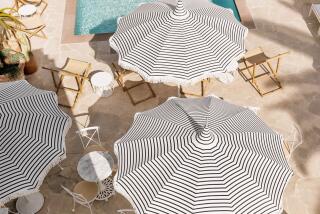Central Coast and a kayak: a lovely autumn combination
With mild temperatures, calm water and minimal fog, there’s no better time of year to visit the Central Coast than the fall, and no better place to see it than on the water in a kayak. And for those prepping for a “big year” of bird-watching, this section of coast, with its diversity of waterfowl and shorebirds, is possibly the finest in California.
If you’ve kayaked only on lakes and prefer water on the tamer side, Morro Bay is the place to paddle. Open-ocean kayaking is a whole different ballgame, and launching from just any beach shouldn’t be attempted by novices (as we learned on a recent trip; more on that in a bit). Just up the coast, San Simeon Cove is a good introduction to swells and surf. We kayaked both areas on a recent autumn weekend and learned a few lessons in the process.
In Morro Bay, as we’ve done many times, we launched kayaks from the Embarcadero. You can rent kayaks there and at Morro Bay State Park. We brought our own single-person sit-inside recreational kayak and rented a second one from Kayak Horizons. Rentals can be launched right from the back of the shop on the Embarcadero, but private kayaks have to put in at the beach near Morro Rock, or at the marina at the south end of the Embarcadero.
Depending on tide and wind conditions, from there it’s an easy paddle to the four-mile-long sandspit that separates the bay from the ocean. Once at the sandspit, which consist of wind-driven dunes that are an extension of Montaña de Oro State Park, we pulled our boats onto the beach and hiked an informal trail across the spit to the ocean side. Wooden stakes usually mark the trail boundary to keep people away from snowy plover nests. (The spit is home to the area’s largest snowy plover nesting population.) Being on the ocean side of the spit always reminds me of the final scene from Planet of the Apes, but even wilder. We’ve never seen another person and the surf is pretty intense. All that’s missing is the Statue of Liberty.
On to the more gnarly stuff up north. We’d heard raves about the kayaking at San Simeon Cove, so headed up there the next day. After my partner rented a sit-on-top kayak from the small rental facility Sea For Yourself at William R. Hearst Memorial State Beach, we launched right from the beach. The waves were small but still challenging for us flat-water paddlers, but once past the surf, we found the water was calm, turning glassy as we got to the cove at the north end of San Simeon Bay. We floated in amazingly clear turquoise-colored water over kelp beds, with shoreline views of Hearst Castle in the distance. We photographed an egret wading on the kelp and cormorants crowded together on shoreline boulders.
It was all very peaceful but I had two nagging thoughts: 1. A recent shark sighting in Cayucos, where we were staying, reminded me that sharks prowl kelp beds in search of sea lions. Hmmm. And hadn’t there been reports of kayakers knocked out of their boats by great whites? And 2. Would we get dumped in the surf trying to get back to shore, as we saw happening to others?
I’m happy to report that we saw no sign of sharks. However, my fear of tipping over became reality when it came time to return to shore. I watched as my partner flipped over in the surf, eventually popping up sans sunglasses. I tightened my straw hat’s chin string and rode a wave in. Paddling like crazy, I realized a wave was pulling me backward. Then, in a flash, I was upside down and out of the boat, minus hat and one Chaco sandal. The sandal eventually washed to shore; the hat’s probably being worn by a sea lion by now.
My tips for kayaking in the surf: 1. Make sure the tops of dry bags are rolled at least three times and safely clipped to the kayak. Despite my rollover, my camera and phone stayed safe and dry. I won’t mention what happened to someone else’s electronics. 2. At San Simeon Cove, it’s easier to return to shore at the far end of the cove (north end), where the surf is gentler than that closer to the pier. This requires hauling your kayak further down the beach, but unless you’re experienced kayaking in waves, it’s worth it.
For those who can’t tell the difference between a hen and a heron, another item that comes in handy is a plastic fold-out card to help ID feathered friends. We keep these handy by lashing them to the fronts of our boats. For the tech-savvy, there are birding smartphone apps. Just make sure to keep all electronic devices safely stowed in that waterproof dry bag clipped to your craft.
We based ourselves in our favorite Central Coast town of Cayucos, the dog-friendliest town south of Carmel (and a bit more rustic). We hadn’t been there in a year or two and were pleasantly surprised to see a few new spots on the main drag: Top Dog Coffee Bar was perfect for a coffee and pastry; for something more substantial in a lovely patio setting, our favorite restaurant Hoppe’s has opened a breakfast and lunch spot directly in back of the restaurant; and at the far north end of Ocean Avenue is Brown Butter Cookie Co. for the most amazing (if a bit pricey) brown butter sea salt cookies.
You can find out more about wildlife of Morro Bay at the website of the Morro Bay National Estuary Program.
More to Read
Sign up for The Wild
We’ll help you find the best places to hike, bike and run, as well as the perfect silent spots for meditation and yoga.
You may occasionally receive promotional content from the Los Angeles Times.






